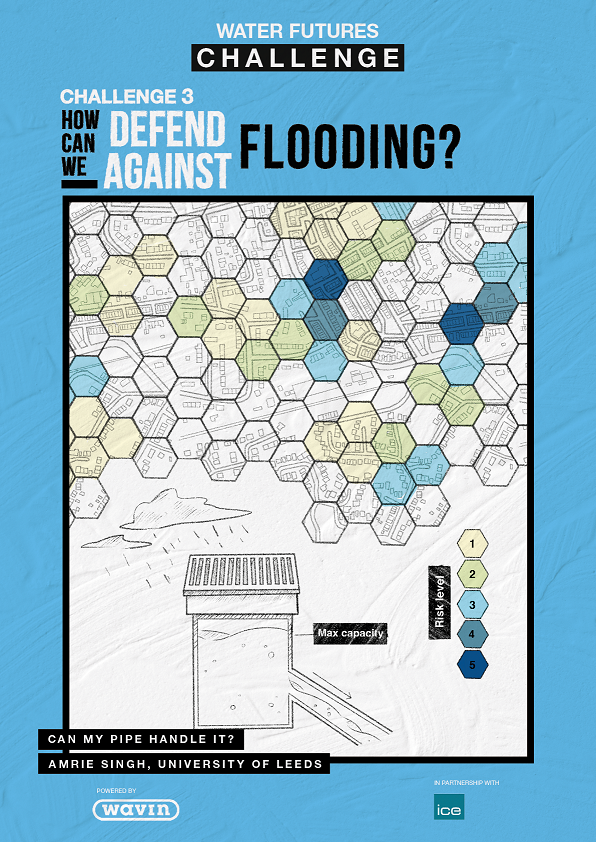For many, the risk of flooding sits alongside thick coats and runny noses as a regular a fixture of the British winter. But wetter winters mean the frequency of these flooding events is increasing, and they are beginning to impact a growing number of communities.
With the Met Office warning that the worst flooding this Winter could come as late as February [1], many people are already on alert.
In his regular column, Mike Ward, UK and Ireland Territory Director at global plumbing and drainage manufacturer Wavin, explains why longer-term thinking is needed to improve resilience against winter flooding.
Climate change is causing more extreme weather events, including longer, heavier and more frequent periods of rain. A UN report released in October 2022 suggests that the organisation saw no ‘credible pathway’ to the 1.5°C target set out in The Paris Agreement [2]. Unless international collaboration can deliver an unlikely turnaround in the very near future, Britain will have to learn to live with more serious and more frequent flooding. Alongside preparing people to react quickly to protect themselves and their homes, long-term strategies should examine how we should update infrastructure, particularly around managing stormwater, to provide futureproof solutions for urban and rural communities.
Saturated ground
Consistent, longer periods of rainfall saturate soils and raise river levels, putting pressure on our existing water infrastructure. A lot of these systems, especially those in urban areas, date back to Victorian times; in many cases, the flood risk has increased dramatically since they were built and policymakers have been put on the back foot, needing to act quickly to limit danger to life and property by investing in ‘quick fix’ measures such as debris screens and flood barriers.
While these measures are important, there is a danger that we become trapped in a cycle of building ever higher walls to defend against ever more serious flooding. It’s also worth thinking about the length of the winter season. With the most serious flooding already expected in February, there’s already a huge burden of worrying hanging over people’s heads. The news that the worst is yet to come will be painful for many people who are already carefully watching forecasts.
Resilient by design
Escaping this cycle requires us to look ahead and prepare for the worst. Public sector stakeholders, including local authorities, planners and policymakers, are rightly looking pragmatically at the risks and encouraging the general public to do the same. In essence, this work is the bandage that it is hoped will shield communities from life and livelihood-threatening impacts of flooding. However, without reaching the root cause of the problem, just stopping the bleeding isn’t a long-term solution. Government investment and policy should be equally focused on updating drainage infrastructure to expand its ability to cope with surges from heavy winter rainfall.
The winning entry to Wavin’s Water Futures Challenge this year highlighted the need for an accurate assessment of drainage capacity in areas threatened by flooding. University of Leeds student, Amrie Singh, submitted ‘Can my pipe handle it?, a proposal to update rainfall/runoff models with precise and up-to-date drainage capacity data. Obtaining and understanding this data will be essential to targeting interventions that expand drainage capacity, and ultimately create urban environments better able to cope with extreme rainfall.
When it comes to futureproofing new homes and infrastructure in areas at risk of flooding, public and private sector developers should be building with the assumption that, at some point, their projects will be at risk of flooding. New build developers are increasingly turning to innovative sustainable drainage solutions (SuDS) to mitigate extreme rainfall events.
An effective SuDS strategy is one that combines below ground infrastructure with natural above ground solutions. This includes solutions such as ponds and swales, which developers can implement to mirror natural soil percolation and bio-filtration. In conjunction with attenuation tanks on developments to safely store water and slowly release it back into the environment during periods of heavy rainfall. This ultimately creates a futureproof urban water cycle, that involves humanmade interventions working alongside natural processes.
With these solutions, the best approach is to evaluate the risk in a specific area, and then implement measures that work best for a particular location.
A change in mindset
To build momentum and achieve the change needed in both the public and private sectors, we must encourage people to view flood defence differently. The reason that better drainage infrastructure and solutions such as SuDS are sustainable is that they work with, rather than against, the natural water cycle.
Strategies based solely on flood barriers, debris gates and other defensive measures leave communities struggling against a current that will only strengthen in coming years. These interventions need to be paired with proactive, preventative action that pulls in the same direction as the natural flow of water.
Rainfall will intensify. Drought will make the ground less permeable. Urbanisation will disrupt natural drainage systems. We can’t keep unwanted flood water out of our communities – we need to learn to live alongside and manage it accordingly.
For more information about Wavin, visit: www.wavin.com.
[1] https://www.theguardian.com/environment/2022/nov/07/met-office-predicts-severe-flooding-across-england-in-february
[2] https://news.un.org/en/story/2022/10/1129912#:~:text=There’s%20%E2%80%9Cno%20credible%20pathway%20to,C%20above%20pre-industrial%20levels.




